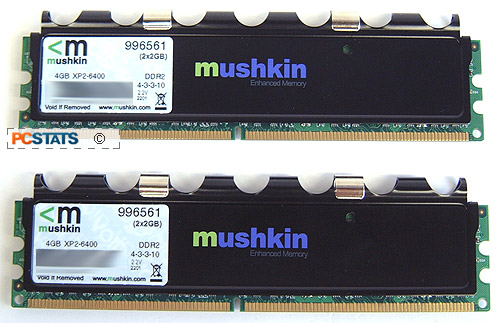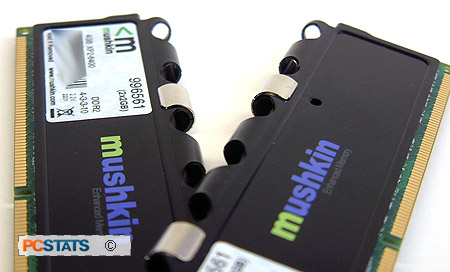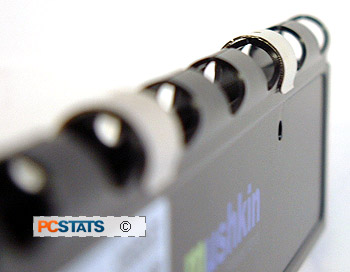Microsoft Windows Vista runs best with about 2GB of
memory installed, or put another way; 1GB is the bare minimum and the
sweet spot is 4GB. If you're a forward thinking computer user, you might want to spring for a 4GB kit of memory right now. Why? well, starting off with two 2GB sticks of memory leaves two memory slots available on most motherboards for future memory additions... and with DirectX10 games popping up all over the place that's good insurance.
Of course, the biggest limitation when it comes to
running a PC with 4GB of RAM is memory
incompatibility.
Cobble together two different pairs of 2GB DDR2 memory sticks and chances are the motherboard will mistakenly report only 2.7GB, 3.3GB or 3.7GB of RAM installed... Worse yet, mixing and matching different 2GB memory sets may force you to use lax memory timings, or even to turn down the memory speed. Bummer.
It's a good thing that Mushkin has produced this high performance 4GB
memory kit... yes, that's FOUR GIGABYTES!
Mushkin quietly released this 4GB
kit (2x 2GB memory modules) of PC2-6400 DDR-2 RAM in the first quarter,
and PCSTATS is excited to finally be testing the modules for you. The
4GB Mushkin XP2-6400 memory kit has a default speed of DDR2-800, or PC2-6400, all
the while maintaining tight CAS latency timings of 4-3-3-10! For 2GB
modules, that's impressive.
High capacity DDR2 with tight timings is a very rare
thing, and it's consequently the kind of memory that commands a significant
price. Mushkin's XP2-6400 4GB memory kit retails for about $635 CDN ($533 USD, £282 GBP),
but when it comes to dual channel 4GB memory kits for performance desktop applications, there
really aren't more than a handful of choices. When you look at some of the other 2GB DDR2 memory
that PCSTATS has tested recently, the price isn't too bad. In fact, it starts
to look like a bargain.
 |
|
Mushkin XP2-6400
Memory |
|
|
 |
|
|
RAM Memory Type: DDR2-800 / PC2-6400
Individual Module
Capacity: 2048MB
Native Speed & Latency: 800 MHz @ CAS
4-3-3-10
Enhanced
Performance Profiles (EPP):
No | |
Mushkin's XP series of memory is designed for PC
enthusiasts and overclockers. The 'XP' stands for eXtreme Performance. In this case, each individual
memory stick is 2GB in size and comes running at
DDR2-800 speeds with timings of 4-3-3-10. To get the memory to operate properly Mushkin recommends
that you set the BIOS to give the DDR2 between 2.2-2.5V. That
is a higher than average voltage, although we should mention that the
memory PCSTATS tested had no difficulties running with just 1.8V (DDR2 stock
voltage).
 To protect the memory modules from physical damage
and keep the DDR2 BGA DRAM modules operating within the ideal temperature
levels, a pair of custom aluminum heatspreaders are used. These black
puppies are called the "FrostByte" heatsink system. The ramsinks are
slightly taller than a typical equivalent, and do seem to work well.
To protect the memory modules from physical damage
and keep the DDR2 BGA DRAM modules operating within the ideal temperature
levels, a pair of custom aluminum heatspreaders are used. These black
puppies are called the "FrostByte" heatsink system. The ramsinks are
slightly taller than a typical equivalent, and do seem to work well.
The heatspreaders have 58% more surface area, and open at the top to improved
airflow in and around the memory module. Mushkin employ an "advanced thermal
adhesive" which apparently has double the thermal conductivity of the
previous material. Sounds good to us.
Removing the heatspreaders can easily damage
memory modules. Most manufacturers bond the heatspreader onto the DRAM modules.
The solder ball contacts on the bottom of the DRAM are fragile and can
be easily damaged if you try to remove a heatspreader. So don't try an remove factory
installed heatspreaders.
Operating System Note:
 Even
though the motherboard PCSTATS tested these 4GB babies with fully recognized the 4GB
Mushkin XP2-6400 memory, WindowsXP didn't quite get it.
Even
though the motherboard PCSTATS tested these 4GB babies with fully recognized the 4GB
Mushkin XP2-6400 memory, WindowsXP didn't quite get it.
According
to WindowsXP, the system was installed with 3.25GB of memory. This is a limitation of
a 32 bit OS, the "missing 750MB" of memory is reserved for hardware devices.
It's possible for the operating system to bypass the 32 bit memory limit of 4GB
to recognize more memory, but that is due to Physical Address Extensions (PAE),
which until recently was primarily a workstation/server option.
Intel has detailed this issue here
and another option is to run a 64 bit operating system like Microsoft WindowsXP
64 bit Edition or the 64 bit versions Windows Vista.
PCSTATS Test
Methodology:
On Intel Socket 775 Core 2 Duo test systems, we're only
interested in seeing how high we can go with the DDR-2 memory running 1:1, as
running with other dividers puts the overclocking bottleneck elsewhere and not
with the system memory. The DDR-2 RAM latency must run at its lowest possible
setting, as quick access is more important to the CPU design. Just for arguments
sake, we will also be conducting overclocking tests to see how high the memory
will go with lax timings (5-5-5-15), although we will only benchmark the system
with the tight memory timings mentioned above. Let's get started and overclock
this 4GB wonder!!

